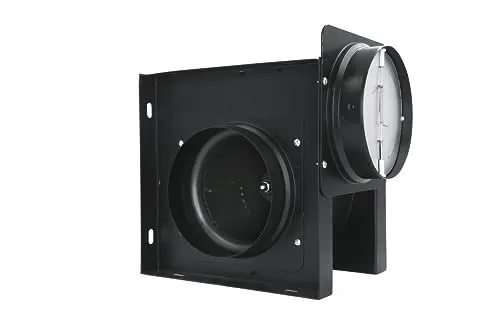Role of a Kitchen Exhaust Fan in Fire Safety

When we think about kitchen safety, our minds often go to smoke alarms, fire extinguishers, and safe cooking practices. However, one of the most overlooked yet crucial components in preventing kitchen fires is the Kitchen Exhaust fan. This simple appliance plays a vital role not only in improving air quality and comfort but also in protecting your home or commercial kitchen from potential fire hazards.
In this blog, we’ll explore how a Kitchen Exhaust fan contributes to fire safety, why proper installation and maintenance are essential, and what to look for in a quality exhaust system.
The Basics: What Does a Kitchen Exhaust Fan Do?
A Kitchen Exhaust fan is designed to remove airborne particles, smoke, heat, moisture, and cooking odors from your kitchen environment. It works by pulling these contaminants through a filtration system and venting them outside your home or into a designated ducting system. But beyond improving air quality, this fan serves as a first line of defense against fire hazards.
How Kitchen Exhaust Fans Help Prevent Fires
1. Reduction of Flammable Grease Build-up
One of the leading causes of kitchen fires—particularly in commercial kitchens—is the accumulation of grease on surfaces, walls, and in ductwork. When you cook, especially with oils and fats, tiny grease particles become airborne and settle on surrounding surfaces. Over time, this build-up becomes highly flammable.
A Kitchen Exhaust fan captures and filters out many of these particles before they can settle and pose a danger. High-quality fans with efficient grease filters can significantly reduce the risk of a grease fire.
2. Control of Heat Buildup
In a busy kitchen, heat from stoves, ovens, and other appliances can create extremely high temperatures. If not properly ventilated, this heat can increase the risk of spontaneous combustion, particularly in kitchens with poor air circulation or overloaded electrical systems.
A properly functioning Kitchen Exhaust fan helps maintain a stable temperature by venting hot air out of the cooking space. This temperature regulation plays a vital role in minimizing fire risk.
3. Removal of Smoke and Toxic Fumes
In the early stages of a fire, smoke and toxic gases are often the first indicators. A Kitchen Exhaust fan removes these elements quickly, keeping visibility clear and giving residents or employees more time to detect and respond to a fire threat.
Moreover, removing these fumes prevents them from spreading throughout the building, which can be critical in maintaining a safe evacuation route.
Fire Code Compliance in Commercial Kitchens
Commercial kitchens are subject to strict fire codes and safety regulations. Installing and maintaining a commercial-grade Kitchen Exhaust fan is not just a safety measure—it’s a legal requirement. According to fire safety codes, all commercial kitchens must have a mechanical ventilation system that includes grease capture and fire suppression capabilities.
A commercial Kitchen Exhaust fan is typically integrated with an automatic fire suppression system. When a fire is detected, the system activates and dispenses a fire-suppressing agent directly into the hood and ducting, significantly reducing the fire’s spread.
Installation Matters: Why You Need a Professional
Improper installation of a Kitchen Exhaust fan can negate its fire safety benefits. For example, incorrect ductwork can cause grease to accumulate in hard-to-clean areas, while an undersized fan might not provide adequate airflow.
Professional installation ensures:
- Correct fan size and placement
- Proper ductwork angles and clearances
- Compliance with fire safety codes
- Integration with fire suppression systems (for commercial setups)
Always work with certified HVAC or ventilation professionals when installing a Kitchen Exhaust fan.
Maintenance is Key to Fire Prevention
Even the best exhaust system can become a fire hazard if not properly maintained. Over time, filters and ductwork can become clogged with grease, dust, and debris, reducing airflow and increasing fire risk.
Here are a few maintenance tips:
- Clean filters regularly: Most manufacturers recommend cleaning filters every month, depending on usage.
- Inspect ductwork: At least once a year, check for blockages and grease accumulation.
- Schedule professional inspections: Especially for commercial kitchens, regular inspections ensure all components are in working order and compliant with local fire codes.
- Replace worn components: Fans, belts, and motors wear over time and should be replaced to maintain performance and safety.
Choosing the Right Kitchen Exhaust Fan
Not all fans are created equal. When selecting a Kitchen Exhaust fan for fire safety, consider the following features:
- Grease filters: Preferably stainless steel baffle filters, which are easier to clean and more fire-resistant.
- CFM rating (cubic feet per minute): Choose a fan with the appropriate CFM for your kitchen size and cooking style.
- Fire-rated materials: The hood and ducting should be made from fire-resistant materials.
- Quiet operation: While not directly related to fire safety, quieter fans encourage regular use, which indirectly enhances safety.
Conclusion: Stay Safe with Reliable Solutions from Astberg Ventilation
A Kitchen Exhaust fan is more than just a comfort appliance—it’s a critical component of your home or commercial kitchen’s fire safety plan. By effectively removing heat, smoke, and grease-laden air, it significantly reduces the risk of kitchen fires and ensures a safer cooking environment.
At Astberg Ventilation, we offer a premium selection of kitchen exhaust fans engineered for performance, energy efficiency, and safety. Whether you’re upgrading your home kitchen or outfitting a commercial space, our products meet high standards of reliability and fire safety compliance.



